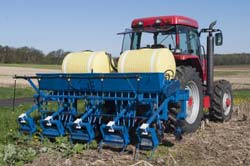Cover crop seeder pulls triple duty for small farms

The multipurpose cover crop seeder prototype, designed and built by Penn State agricultural scientists, could save farmers $10 to $20 an acre by performing two to three operations at once. The seeder scores the soil, plants seed, adds herbicides and sprays fertilizer in a single trip. Credit: Patrick Mansell, Penn State<br>
Pennsylvania farmers are increasingly interested in growing cover crops, but the time, cost and late fall harvest of corn and other crops often limit their use, said Gregory Roth, professor of agronomy.
The seeder can help farmers, especially small operations, save time and money by condensing multiple tasks into one trip through a no-till field. It would also allow farmers to seed fields that lacked cover crops due to late season and cost concerns.
“It can do three things in one pass,” Roth said. “It can seed the cover crop, add fertilizer and spray an herbicide to kill emerged weeds.”
Unlike plowing, no-till farming uses a minimal amount of ground disturbance when planting seeds, a method that improves the soil and prevents erosion. Cover crops play an important role in reducing runoff and helping to build organic material in the soil during the fall and spring.
A tractor pulls the seeder through the cornfield rows using a sensor to guide the device between the rows. The device has several blades that lightly till the ground between the cornrows creating a planting swath. The seeds drop onto the soil and a follow-up roller packs the seed into place.
At the same time, the machine strategically applies a fertilizer and herbicide. The research team created a prototype using a number of existing technologies from agricultural equipment manufacturers.
According to Roth, the best time to use the device is six weeks after the corn is planted. If the cover crop is planted too early, it can compete with the corn plants; if it is planted too late, the corn crop may be too competitive for the cover crop to grow.
A single pass through a field costs the farmer approximately $10 an acre, Roth said. By saving one to two trips through the fields, farmers could save $10 to $20 per acre.
Other methods of planting cover crops during the growing season — such as using an airplane to drop seeds on the field — are expensive and only moderately successful. Roth said the alternative methods are only effective in establishing a cover crop about half the time.
The researchers tested the seeder last summer in three studies at Penn State's Russell E. Larson Agricultural Research Center, said William Curran, professor of weed sciences. In each of the studies, the crop seeder was successful in establishing cover crops without any impact on corn yields.
The researchers tested three cover crops — annual ryegrass, red clover and white clover. They also tested a mixture of ryegrass and clover. Because ryegrass and clover can prevent soil erosion and serve as a natural source of nitrogen, farmers also may not need to purchase as much fertilizer.
“We picked cover crops that we thought would work and chose the ones that we thought had the best chance to be successful,” Curran said.
The researchers said they are pleased with the results of the first tests, but have more work to do to perfect the seeder.
“We really had just one season for research and we basically tested things that we were pretty sure would be successful,” said Curran. “Now we have to do more research before we feel the results are of value and we feel confident in what we're doing.”
If the seeder is marketed, the researchers believe that the device will be inexpensive enough for use on smaller farms.
The researchers have filed a provisional patent on this device.
Video is available at: http://www.youtube.com/watch?v=Pi0zbO61DgA&feature=email
Media Contact
More Information:
http://www.psu.eduAll latest news from the category: Agricultural and Forestry Science
Newest articles

Nerve cells of blind mice retain their visual function
Nerve cells in the retina were analysed at TU Wien (Vienna) using microelectrodes. They show astonishingly stable behavior – good news for retina implants. The retina is often referred to…

State-wide center for quantum science
Karlsruhe Institute of Technology joins IQST as a new partner. The mission of IQST is to further our understanding of nature and develop innovative technologies based on quantum science by…

Newly designed nanomaterial
…shows promise as antimicrobial agent. Rice scientists develop nanocrystals that kill bacteria under visible light. Newly developed halide perovskite nanocrystals (HPNCs) show potential as antimicrobial agents that are stable, effective…



